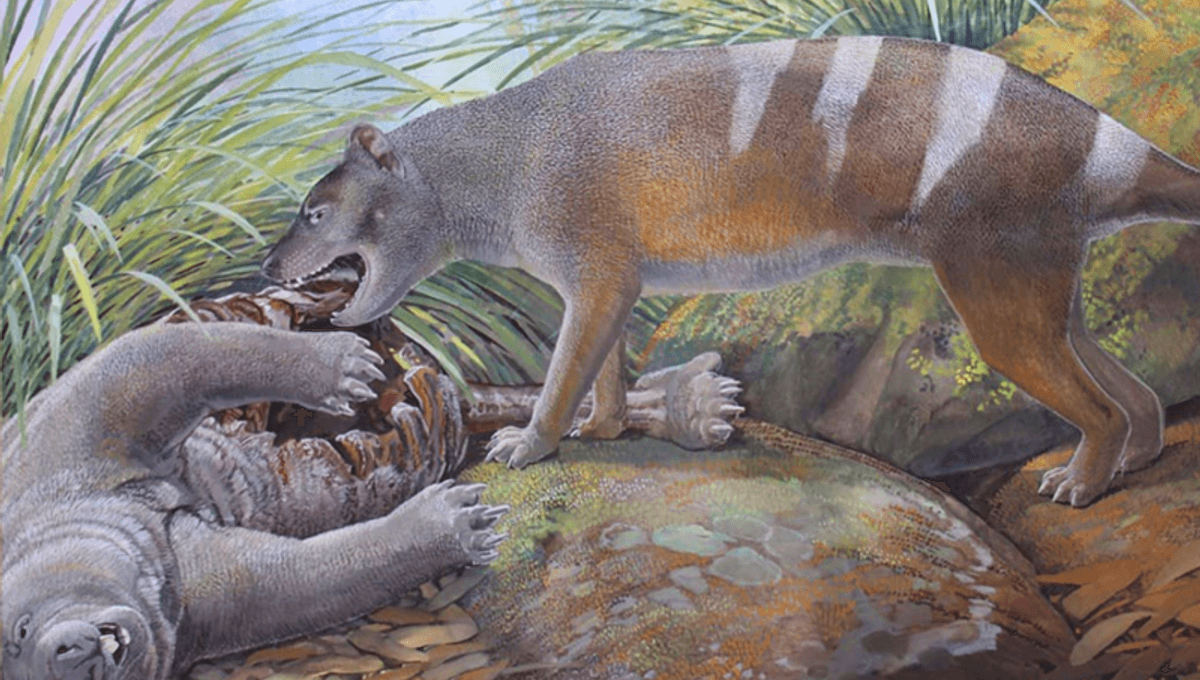
The last known Tasmanian tiger died 88 years ago – but now, fossil evidence of three new species of the extinct marsupial has been discovered in Australia. Among the new species are the cursed carnivore’s earliest-known ancestor and the oldest thylacine known to date, which was the proud owner of a terrifying, bone-crushing jaw.
Tasmanian tigers – also known as thylacines – are extinct marsupials that were native to the Australian mainland and the islands of Tasmania and New Guinea before going extinct in the 20th century (although exactly when this happened is up for debate).
The three new ancient species – Badjcinus timfaulkneri, Nimbacinus peterbridgei, and Ngamalacinus nigelmarveni – roamed Australia 23 to 25 million years ago, during the late Oligocene, placing them among the oldest thylacinids ever discovered. In fact, B. timfaulkneri is thought to be the oldest undoubted thylacine we know of.
The fossils were unearthed in deposits of the Riversleigh World Heritage Area in northwestern Queensland. As well as being the oldest, B. timfaulkneri is the largest of the new species, weighing in at around 7-11 kilograms (15-24 pounds). It also possessed an extremely strong jaw, allowing it to crush the bones and teeth of its prey.
The species is related to another much smaller thylacine, B. turnbulli, which until now was the only other undoubted thylacinid known from the late Oligocene.
“The once suggested idea that Australia was dominated by reptilian carnivores during these 25 million-year-long intervals is steadily being dismantled as the fossil record of marsupial carnivores, such as these new thylacinids, increases with each new discovery,” Timothy Churchill, lead author of a paper presenting the findings, said in a statement.
“The diversity of mammalian carnivores at Riversleigh during this period rivals that seen in any other ecosystem, including the great mammalian carnivore radiation that developed in South America.”
The second newly discovered species, N. peterbridgei, appears more closely related to the Tasmanian tiger than the other fossils, making it probably the oldest direct ancestor of the recently extinct carnivore. It was slightly smaller than the other two species at 3.7 kilograms (8 pounds).
N. nigelmarveni, meanwhile, weighed 5.1 kilograms (11 pounds) and had “meat-cutting” notches on its teeth, suggesting it was highly carnivorous – perhaps more so than any other thylacinids of similar size.
“The presence of three distinct lineages of specialised thylacinids during the late Oligocene highlights how quickly they diversified after first appearing in the fossil record,” co-author Professor Michael Archer said.
“These thylacinids exhibit very different dental adaptations, suggesting there were several unique carnivorous niches available during this period. All but one of these lineages, the one that led to the modern Thylacine, became extinct around 8 million years ago.”
The last known thylacine died in a zoo on September 7, 1936. The date has since become Australia’s National Threatened Species Day, and this year was marked with the publication of this latest thylacine research.
The study is published in the Journal of Vertebrate Paleontology.
Source Link: Newly Discovered Thylacine Ancestor Was Proud Owner Of A Terrifying, Bone-Crushing Jaw